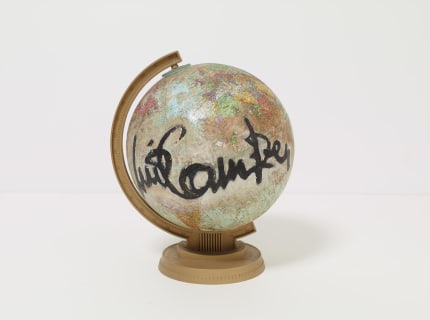Luis Camnitzer is included in the joint exhibition Porter-Camnitzer: The New York Graphic Workshop at the National Museum of Fine Arts of Chile, 1969-2024 at the Museo Nacional de Bella Artes, Santiago, Chile.
The Museo Nacional de Bella Artes's press release follows:
Between October 17 and February 23, 55 years after their joint exhibition at the MNBA, two great figures of contemporary art will meet in the museum's galleries. The exhibition Porter-Camnitzer: The New York Graphic Workshop at the Museo Nacional de Bellas Artes de Chile, 1969-2024, revives a key moment for Latin American art and provides elements for reflection on the circulation of artistic and historiographical narratives.
This is a review of a relevant period in the production of Liliana Porter (Argentine, born in Buenos Aires, 1941) and Luis Camnitzer (Uruguayan, born in Lübeck, Germany, 1937), who, curated by Silvia Dolinko, are once again exhibiting works presented in 1969 at the MNBA, during the first direction of Nemesio Antúnez, as part of his efforts to open up to new artistic practices, for the desacralization of art and the museum. On that occasion, the exhibition went almost unnoticed; however, today, the installations conceived for that space constitute fundamental references for contemporary Latin American art.
“This is an exhibition that makes us proud because it fulfils several of the MNBA’s ambitions. Firstly, it nourishes our programme with two of the most relevant exponents of contemporary Latin American art. It is also an opportunity that allows us to recover part of the Museum’s memory in years where experimentation in art was crucial. Re-contextualising that period from the present will allow us to bring conceptual art from the late sixties closer to new generations, as well as the history of the Museum in a time when it opened itself in a visionary way to the experimental practices of those years,” explains Varinia Brodsky, MNBA director.
“The interventions by Luis Camnitzer and Liliana Porter in Santiago, carried out during their collaborative work within the framework of the New York Graphic Workshop, are not only fundamental milestones in their respective careers, but also in the history of contemporary art. This will be the first time that Masacre de Puerto Montt and Ambientación de la arruga II will be re-installed in the same institutional space that originally hosted them. Returning to that historical experience today allows us to redefine a key moment in Latin American art and reflect on the circulation of artistic and historiographical narratives,” highlights Silvia Dolinko, curator of the exhibition.
Porter and Camnitzer, together with José Guillermo Castillo, formed the New York Graphic Workshop (NYGW) in 1964. Among its objectives, it was to redefine printmaking, emphasize its conceptual nature, use innovative editing methods, and function as a workshop open to reflection on graphics. Throughout its years of activity, they presented their works in different cities in Latin America (Mexico City, Caracas, Santiago, Buenos Aires, Montevideo). Their last participation was in 1970, in the exhibition Information , at the MoMA in New York. As part of the Latin American itinerary of the NYGW, the Porter and Camnitzer exhibition was included in this museum.
In 1969, at the Sala Forestal of the MNBA, Liliana Porter presented an installation, Ambience of the Wrinkle . With humor, she intervened the sculptures in the entrance hall with crumpled paper balls, as if they were clues; in the room she arranged a series of objects and walls covered with crumpled paper, as well as blocks of printed sheets with folds, which people could tear off, dent and throw away. This proposal implied a critique of the virtuoso tradition of graphic art, the consumer economy and the art market and its speculative nature. Thus, instead of admiring and framing the work, Porter enabled the public to crumple it, throw it away, destroy it or do whatever they wanted with it.
At the same exhibition, Camnitzer presented the installation Puerto Montt Massacre , in which he made reference, as a form of denunciation, to the act of repression against a group of residents of that city by police forces, which caused the death of a dozen people and wounded fifty others, and which occurred in 1969. He covered the floor and walls of the room with words alluding to the trajectory of the bullets and the scene of the crime. This work is considered one of the most important pieces of political conceptualism in Latin American art. This will be the first time that it has been exhibited again in the same museum, after more than fifty years.
Also included is the work Ventana , conceived by Camnitzer while working at the museum, after seeing the oppression of a student demonstration demanding University Reform. He used the back of a painting discarded by the artist Iván Vial to mark words (with stencil letters) that alluded to this event, such as cordillera, Parque Forestal, carabinero. In this way, he questioned the notion of the painting as a window to reality.
The installations by Porter and Camnitzer will be displayed in dialogue with other pieces by the artists, from the same period of their activity at the NYGW, belonging to public and private collections. Meanwhile, a palette will be installed on one side of the museum's façade with Camnitzer's phrase: "The museum is an attitude," a text that invites us to question the role of these spaces in the 21st century.

